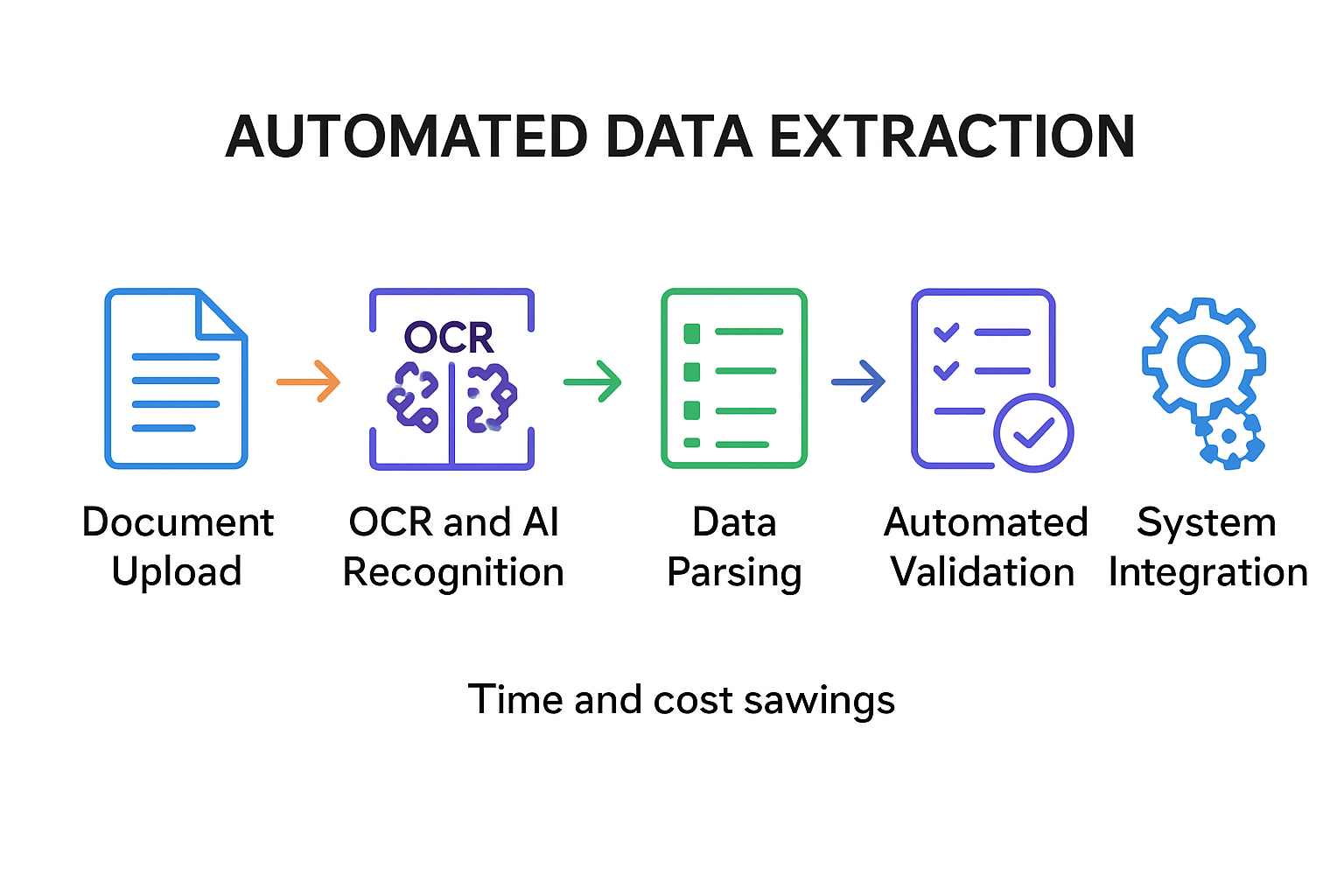Automated data extraction is transforming how finance teams manage invoices and crunch large volumes of financial data. Most people think it just saves you a bit of time on data entry, but that hardly scratches the surface. Some businesses are cutting invoice processing costs from $15 down to as little as $1 per invoice, and slashing extraction time from minutes to under 27 seconds. That is not just faster and cheaper, it is a fundamental shift in how companies handle accuracy, compliance, and growth.

Automated Data Extraction: Streamline Invoice and Finance Tasks
Table of Contents
- What Is Automated Data Extraction?
- Key Benefits For Finance Teams And Businesses
- How Automated Data Extraction Works In Invoice Processing
- Choosing The Right Data Extraction Tools For Your Needs
Quick Summary
| Takeaway | Explanation |
|---|---|
| Automate data extraction to save time | Businesses can process hundreds of invoices in minutes, dramatically cutting down manual processing time and labor costs. |
| Increase accuracy and compliance | Automated systems minimize human errors in data entry and ensure compliance with financial regulations, protecting against costly mistakes. |
| Enhance scalability in processing | These tools efficiently handle growing volumes of invoices without losing performance, allowing businesses to scale operations seamlessly. |
| Integrate with existing financial systems | Automated extraction tools can easily connect with ERP and accounting software, simplifying workflows and data management. |
| Invest in advanced extraction technologies | When choosing tools, prioritize those with high accuracy rates, adaptability, and robust security features to ensure long-term operational excellence. |
What Is Automated Data Extraction?
Automated data extraction represents a technological breakthrough in transforming how businesses process complex documents like invoices and financial records. At its core, this process uses advanced artificial intelligence and machine learning algorithms to automatically identify, capture, and convert unstructured information into structured digital data without manual intervention.
The Fundamental Mechanics of Automated Data Extraction
Research from Wikipedia defines data extraction as retrieving critical information from various sources, converting unorganized content into actionable insights. In the context of financial documents, automated data extraction goes beyond simple copying. It intelligently recognizes specific data points such as invoice numbers, vendor details, transaction amounts, and dates, regardless of the document’s format or layout.
The technology works through sophisticated optical character recognition (OCR) and pattern recognition techniques. These systems can process multiple document types instantaneously - whether they are scanned PDFs, digital images, or electronic files. By analyzing text, understanding context, and cross-referencing information, AI-powered extraction tools ensure high accuracy and reliability.
Key Benefits and Technological Advantages
According to a research study on Robotic Process Automation, automated data extraction offers transformative benefits for businesses. The primary advantages include dramatically reduced manual processing time, minimized human error, and enhanced operational efficiency. Companies can process hundreds or thousands of invoices in minutes, a task that would traditionally require days of human labor.
Moreover, these systems provide exceptional scalability. Unlike human workers who become fatigued or inconsistent, automated data extraction tools maintain consistent performance levels regardless of document volume. They can seamlessly handle complex scenarios like varying invoice formats, multilingual documents, and intricate financial records.
The technology also integrates smoothly with existing financial systems. After extracting data, these tools can automatically populate accounting software, enterprise resource planning (ERP) systems, and other business intelligence platforms. This seamless integration helps businesses optimize their financial workflows by eliminating manual data entry and reducing potential transcription errors.
Beyond efficiency, automated data extraction provides enhanced data security and compliance. By removing human touchpoints, organizations minimize the risk of sensitive financial information being mishandled or exposed. The AI-driven systems maintain strict data privacy protocols and can be configured to adhere to specific regulatory requirements across different industries.
In an era of digital transformation, automated data extraction is not just a technological convenience but a strategic necessity. It empowers businesses to redirect human resources from repetitive administrative tasks towards more strategic, value-added activities that drive growth and innovation.
Key Benefits for Finance Teams and Businesses
Automated data extraction offers transformative advantages for finance teams and businesses seeking to optimize their operational efficiency and strategic capabilities. By leveraging advanced technological solutions, organizations can unlock significant performance improvements across multiple critical business dimensions.
Dramatic Cost and Time Savings
According to NASSCOM, automating invoice processing can reduce processing costs from $15 per invoice to as low as $1. This substantial reduction represents a game-changing financial optimization for businesses of all sizes. Research from Systems journal further supports this, demonstrating that AI-enabled systems can reduce invoice data extraction time to less than 27 seconds, compared to over three and a half minutes for manual methods.
The time savings translate directly into operational efficiency. Finance teams can redirect human resources from repetitive data entry tasks to more strategic activities like financial analysis, planning, and decision-making. By eliminating manual data processing, businesses can significantly reduce administrative overhead and allocate resources more effectively.
Below is a table summarizing the dramatic improvements in efficiency and cost when businesses implement automated data extraction for invoice processing. This table highlights key statistics mentioned in the article and makes the benefits scannable for decision makers.
| Metric | Manual Processing | Automated Extraction |
|---|---|---|
| Cost per Invoice | $15 | as low as $1 |
| Processing Time per Invoice | > 3.5 minutes | < 27 seconds |
| Human Error Rate | Higher (prone) | Minimal (near-perfect) |
| Scalability | Limited | High |
| Compliance Handling | Manual | Automated |
Enhanced Accuracy and Compliance
Manual data entry is inherently prone to human errors, which can lead to significant financial discrepancies and compliance risks. Automated data extraction technologies provide near-perfect accuracy, ensuring that every financial document is processed with minimal mistakes. Research on Robotic Process Automation demonstrates that RPA bots complete invoice processing tasks with exceptional precision, mitigating the risk of costly errors.
Moreover, these systems can be configured to adhere to specific regulatory requirements, maintaining strict data privacy protocols. This automated compliance mechanism reduces the risk of financial penalties and ensures that businesses maintain high standards of data management and integrity. Learn more about optimizing financial workflows through advanced data extraction technologies.
Scalability and Business Intelligence
As businesses grow, the volume of financial documents increases exponentially. Automated data extraction provides unparalleled scalability, capable of processing hundreds or thousands of invoices simultaneously without compromising performance or accuracy. Unlike human workers who become fatigued or inconsistent, these AI-driven systems maintain uniform efficiency across varying document volumes and complexities.
Beyond processing, these technologies generate valuable business intelligence. By converting unstructured documents into structured, analyzable data, finance teams can gain deeper insights into spending patterns, vendor relationships, and financial trends. This data-driven approach enables more informed strategic decision-making, helping businesses identify cost-saving opportunities and optimize their financial strategies.
The integration of automated data extraction represents more than a technological upgrade. It is a strategic investment that empowers finance teams to transform from administrative processors to strategic business partners, driving organizational efficiency, accuracy, and growth.
How Automated Data Extraction Works in Invoice Processing
Automated data extraction in invoice processing represents a sophisticated technological ecosystem that transforms unstructured documents into actionable digital information. This advanced system combines multiple cutting-edge technologies to ensure precise, efficient, and reliable data capture across diverse invoice formats and sources.
Advanced Recognition and Preprocessing Technologies
Research from Wikipedia reveals that invoice processing automation employs Intelligent Data Capture (IDC) systems capable of extracting content without predefined templates. These systems utilize multiple recognition methods including optical character recognition (OCR) for machine-printed text, intelligent character recognition (ICR) for handwritten entries, and specialized barcode recognition techniques.
The preprocessing stage is critical. Before data extraction begins, AI algorithms analyze the document’s structure, identifying potential data zones, detecting text orientation, and normalizing image quality. This preparatory step ensures that subsequent extraction processes can handle variations in invoice designs, fonts, and layouts with remarkable accuracy. Explore our comprehensive guide on advanced data extraction techniques to understand these intricate preprocessing mechanisms.
Machine Learning and Data Validation Mechanisms
According to a research article on DevOps and machine learning, invoice processing involves sophisticated model training and validation workflows. Machine learning algorithms are trained on extensive datasets, learning to recognize patterns, understand contextual relationships, and distinguish between critical data points such as vendor names, invoice numbers, total amounts, and line items.
The validation process is equally sophisticated. After initial data extraction, AI systems cross-reference captured information against multiple validation rules. These might include checking numeric consistency, verifying vendor information against external databases, and flagging potential anomalies or potential fraudulent entries. This multi-layered validation ensures that extracted data meets high accuracy and reliability standards.
Integration and Workflow Automation
Once data is extracted and validated, automated systems seamlessly integrate this information into broader financial ecosystems. The extracted data can be automatically routed to accounting software, enterprise resource planning (ERP) systems, or other financial management platforms. This integration eliminates manual data entry, reduces human error, and accelerates the entire invoice processing workflow.
Moreover, these systems are designed with remarkable adaptability. They can continuously learn from new invoice formats, improving their recognition capabilities over time. This means that as businesses encounter invoices from new vendors or with unique layouts, the AI-driven extraction tool can quickly adapt and maintain high performance.
The technological sophistication of automated data extraction goes beyond mere information capture. It represents a strategic approach to transforming financial document processing, turning complex, time-consuming tasks into streamlined, intelligent workflows that provide businesses with accurate, immediately usable data. By combining advanced recognition technologies, machine learning, and seamless integration capabilities, these systems are redefining how organizations manage and leverage their financial information.

Choosing the Right Data Extraction Tools for Your Needs
Selecting the appropriate data extraction tool is a critical decision that can significantly impact your organization’s financial efficiency and operational productivity. The right solution can transform complex document processing, while an ill-fitted tool can create more challenges than it solves.
Evaluating Technical Capabilities and Performance
Research from a 2025 deep learning study demonstrates that modern invoice validation systems require sophisticated technical capabilities. When choosing a data extraction tool, businesses must assess several key technical dimensions. These include accuracy rates, machine learning adaptability, support for multiple document formats, and integration capabilities with existing financial systems.
The most advanced tools leverage deep learning and neural network technologies that can generalize across different invoice layouts without extensive configuration. Learn more about advanced invoice extraction techniques to understand the nuanced requirements of modern data extraction platforms. Businesses should prioritize solutions that offer high accuracy rates, typically above 95%, and can handle complex, unstructured documents with minimal manual intervention.
Scalability and Cost Considerations
According to research on Robotic Process Automation, scalability is a crucial factor in selecting data extraction tools. Organizations must consider not just current document processing volumes but potential future growth. The ideal solution should offer flexible pricing models that accommodate increasing document volumes without exponential cost increases.
Key scalability factors include the tool’s ability to process multiple document types simultaneously, handle peak workflow periods, and integrate seamlessly with various accounting and enterprise resource planning (ERP) systems. Cost considerations extend beyond the initial investment to include implementation expenses, training requirements, and potential productivity gains. Advanced tools might have higher upfront costs but can deliver substantial long-term efficiency improvements.
Security, Compliance, and Integration Features
In the financial sector, data extraction tools must meet rigorous security and compliance standards. The selected solution should provide robust data protection mechanisms, including encryption, secure data handling, and compliance with industry-specific regulations like GDPR, HIPAA, or financial services guidelines.
An excellent data extraction tool offers comprehensive integration capabilities. This means seamless connectivity with accounting software, cloud storage solutions, and workflow management platforms. The tool should support multiple export formats, enable real-time data synchronization, and provide comprehensive audit trails for tracking document processing activities.
To help you evaluate and select the best automated data extraction tool, here is a table summarizing the key considerations outlined in the article. This checklist provides an at-a-glance overview of important features and selection criteria to review when assessing solutions.
| Selection Factor | What to Look For | Importance |
|---|---|---|
| Accuracy | >95% accuracy, handles complex formats | Critical for reliability |
| Scalability | Handles growing doc volume, flexible pricing | Essential for future growth |
| Integration | Seamless with ERP, accounting, cloud, export formats | Streamlines workflow |
| Security & Compliance | Encryption, data privacy, industry compliance | Protects sensitive business data |
| Machine Learning Adaptability | Learns from new layouts, continuous improvement | Reduces manual reconfiguration |
| Cost Considerations | Upfront vs. long-term savings, implementation cost | Total cost of ownership |
Additionally, look for tools that offer continuous learning capabilities. Research from the CloudScan study highlights the importance of systems that can adapt and improve their recognition capabilities over time, reducing the need for manual reconfiguration and maintaining high performance across evolving document landscapes.
Ultimately, choosing the right data extraction tool is not just a technological decision but a strategic one. It requires a holistic assessment of your organization’s current needs, future growth potential, and the specific challenges of your document processing workflows. By carefully evaluating technical capabilities, scalability, security features, and integration potential, businesses can select a solution that not only meets their immediate requirements but also supports long-term operational excellence.

Frequently Asked Questions
What is automated data extraction?
Automated data extraction is a technology that uses artificial intelligence and machine learning to automatically capture and convert unstructured information from documents, such as invoices, into structured digital data without manual intervention.
How does automated data extraction improve accuracy?
Automated data extraction minimizes human errors commonly associated with manual data entry. Advanced algorithms ensure high accuracy by intelligently recognizing specific data points such as invoice numbers and transaction amounts, while also adhering to compliance regulations.
What are the cost savings associated with automated data extraction?
Businesses can significantly reduce invoice processing costs, with savings reported from $15 per invoice down to as low as $1. The technology also cuts the processing time from over 3.5 minutes to less than 27 seconds per invoice.
How does automated data extraction integrate with existing financial systems?
Automated data extraction tools can seamlessly connect with accounting software, enterprise resource planning (ERP) systems, and other business intelligence platforms, streamlining workflows and enhancing data management.
Ready to Leave Slow and Costly Invoice Processing Behind?
Manual data entry drains productivity and exposes your business to errors. As the article outlines, finance teams waste critical hours and resources processing invoices by hand. High error rates and compliance risks can threaten your operations. You deserve a solution that delivers instant, structured data and lets you focus on growth.

Stop letting old processes hold your team back. Discover how Invoice Parse transforms invoice management with cutting-edge AI-powered extraction. You get real-time results and eliminate the need for templates or manual corrections. Experience the ease of drag-and-drop uploads and instant exports to tools like Excel or Power BI.
Act now and see how your organization can achieve near-perfect accuracy and save dramatically on every invoice. Explore our plans and pricing for businesses of every size. Start your upgrade to error-free, efficient invoice processing today.
Recommended
- AI Invoice Parse – The Ultimate Guide to Data Extraction from Invoices (2025)
- AI Invoice Parse – Invoice Extraction Guide: Best Practices for 2025
- AI Invoice Parse – Extract Invoice Data Guide: Best Practices for 2025
- AI Invoice Parse – Invoice Data Guide: Efficient Processing in 2025
- Automating Workflow with Adobe Acrobat’s Actions
- RPA Invoice Automation is the best way to automate your invoicing process
